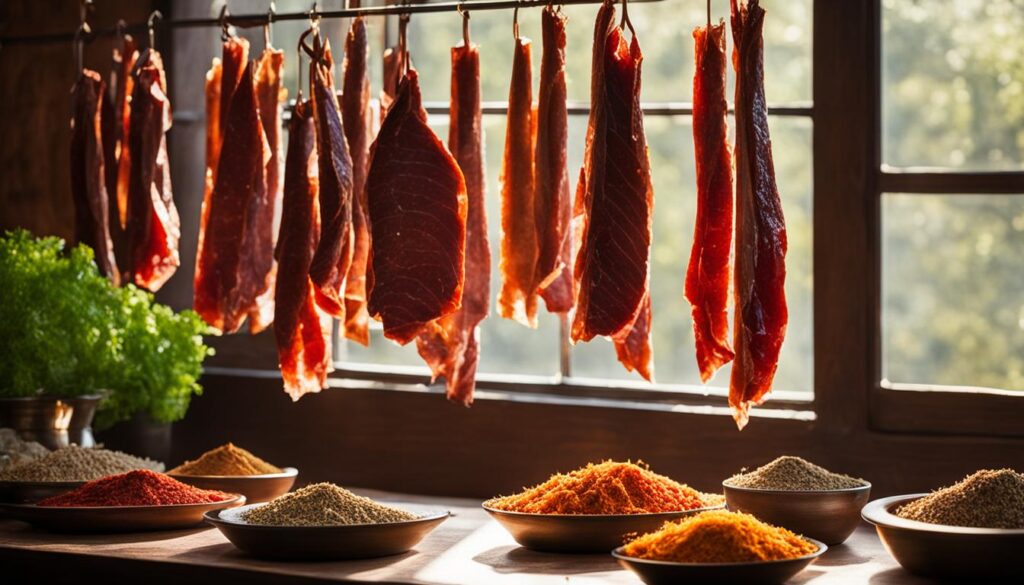Make Biltong Sticks at Home: A Simple Guide
Welcome to our simple guide on how to make homemade biltong sticks. If you’re a fan of this delicious South African dried meat snack, you’ll be delighted to learn how easy it is to create your own biltong sticks right in your kitchen. Using our step-by-step recipe, we’ll show you everything you need to know to achieve mouth-watering results. So, let’s dive in and discover the art of making biltong sticks!
Key takeaways:
- Discover the joy of making homemade biltong sticks in your own kitchen.
- Learn how to choose the right cut of meat and the best spices for your biltong sticks.
- Explore different drying methods to ensure perfect texture and flavor.
- Personalize your biltong sticks by experimenting with various seasonings and flavors.
- Share your homemade biltong sticks with family and friends for a truly satisfying experience.
The Art of Drying Biltong Sticks
Once you have prepared your biltong sticks with the desired flavors and seasonings, the next crucial step is the drying process. Properly drying the biltong sticks not only ensures that they are safe to eat but also enhances their flavor and texture.

The drying time for biltong sticks can vary depending on factors such as the thickness of the meat slices or strips and the drying conditions. On average, biltong sticks can take 1 to 2 days to dry, while whole biltong may require 3 to 4 days in a home dryer.
Once the biltong sticks are completely dry, you can remove them from the dryer. At this point, you have two options: enjoy them immediately or store them for later consumption. Biltong sticks can be a convenient and delicious snack to take on the go, making them a popular choice among biltong enthusiasts.
For those who want to explore different flavours, the drying process provides an excellent opportunity. After mastering the basic biltong making process, you can experiment with various sauces and seasonings. For example, try coating the biltong sticks with Sweet Chilli or Nou Gaan Ons Braai Extra Hot Peri-Peri before hanging them to dry. This allows the flavours to infuse into the meat, resulting in a unique and tantalising taste experience.
Creating the ideal drying conditions is crucial for achieving the best results. Biltong needs good airflow and relatively cool temperatures to concentrate the meat’s flavor while removing moisture. Contrary to popular belief, heat is not necessary for drying biltong sticks. Instead, you can use a biltong box with a fan and lightbulb or set up a homemade drying system to ensure sufficient airflow.
When determining if the biltong sticks are fully dry, gently squeeze the meat. It should feel dry to the touch but still have a slight give. This ensures that the biltong sticks are adequately dried but not overly tough.
It’s important to note that creating the right drying conditions helps prevent case hardening. Case hardening occurs when the outer layer of the biltong becomes too tough while the interior remains moist. To avoid case hardening, maintain the appropriate temperature and airflow throughout the drying process, allowing for an even and gradual drying process.
| Benefits of Proper Drying: | Consequences of Improper Drying: |
|---|---|
| – Enhanced flavor | – Risk of spoilage |
| – Concentrated meat texture | – Case hardening |
| – Extended shelf life | – Loss of flavor |
Conclusion
Making biltong sticks at home is a truly satisfying process that allows you to create delicious snacks with ease. By following a simple step-by-step guide and using the right equipment and ingredients, you can achieve fantastic results.
The key to making mouthwatering biltong sticks lies in the selection of a good cut of meat, the perfect seasoning, and a well-controlled drying process. Whether you prefer Silverside or Topside, these cuts provide the ideal balance of flavour and tenderness.
With the right biltong sticks seasoning, you can elevate the taste to new heights. From classic combinations like coriander, salt, and pepper, to exciting flavours like Smokey, Chilli, Sweet Chilli, Lemon Pepper, or BBQ, the choice is yours. Experimenting with different seasonings can lead you to discover your own unique and irresistible biltong sticks.
Once you’ve mastered the biltong sticks drying process, you’ll be able to enjoy the fruits of your labor. Share the joy of homemade biltong sticks with friends and family, or savour them as a tasty snack for yourself. So why wait? Start your biltong-making adventure today and experience the satisfaction of creating easy biltong sticks that everyone will love.
FAQ
What is biltong?
Biltong is a traditional South African dried meat snack that is typically made from beef, but can also be made with venison, pork, or chicken.
What is the best cut of meat to use for making biltong sticks?
The best cut of meat to use for making biltong sticks is Silverside or Topside, as they have a nice amount of fat on the top.
What equipment options are there for drying biltong?
There are various equipment options for drying biltong, such as a stainless steel biltong dryer, a homemade drying cabinet, a small dryer, or hanging under nets with a fan on in a box.
What tools do I need for making biltong sticks?
To make biltong sticks, you will need knives, a large dish, biltong hooks or paper clips, and plastic or brown paper bags.
What are the spice options for biltong?
Spice options for biltong include traditional flavors like coriander, salt, pepper, and sugar, as well as additional flavors like Smokey, Chilli, Sweet Chilli, Lemon Pepper, and BBQ.
Can I make my own biltong spice?
Yes, biltong spice can be made from scratch or bought pre-made. The choice of adding brown vinegar and Worcestershire Sauce is up to personal preference.
What is the process of making biltong sticks?
The process of making biltong sticks involves cutting the meat into slices or strips, soaking them in a mixture of Worcestershire Sauce and Brown Vinegar, applying the spice mix, and then leaving the meat to soak and hang until dry.
How long does it take for biltong sticks to dry?
Biltong sticks can take 1 to 2 days to dry, while whole biltong can take 3 to 4 days in a home dryer.
What can I do with the biltong sticks once they are dry?
Once the biltong sticks are dry, they can be removed from the dryer and either eaten immediately or packed away for later.
Can I experiment with different flavors for my biltong sticks?
Absolutely! After mastering the basic process of making biltong sticks, you can experiment with different flavors by coating the biltong with sauces like Sweet Chilli or Nou Gaan Ons Braai Extra Hot Peri-Peri before hanging it to dry.
Do I need heat to make biltong sticks?
No, heat is not required for making biltong sticks. The use of a biltong box with a fan and lightbulb or a homemade drying setup can provide sufficient airflow.
How can I determine the doneness of biltong sticks?
The doneness of biltong sticks can be determined by lightly squeezing the meat to check for dryness while still allowing a little bit of give.
What should I do to avoid case hardening when drying biltong sticks?
It is important to create the right drying conditions to avoid case hardening, where the outside of the biltong becomes overly tough. This can be achieved by ensuring good airflow and relatively cool temperatures during the drying process.
Is making biltong sticks at home difficult?
Making biltong sticks at home is a rewarding and delicious process that allows you to customize the flavors to your liking. By following a simple step-by-step guide and using the appropriate equipment, you can achieve great results.
What are the key ingredients for making biltong sticks?
The key ingredients for biltong sticks include a good cut of meat, the right spices, and a well-controlled drying process.
Can I create my own unique biltong sticks?
Once you have mastered the basic process, you can start experimenting with different flavors and seasonings to create your own unique biltong sticks.
What is the satisfaction in making biltong sticks?
Enjoy the satisfaction of crafting homemade biltong sticks and sharing them with family and friends.
